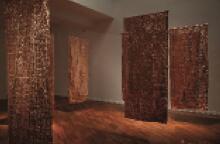Cecilia Paredes
German Kruger Instituto Cultural Peruano-Norteamericano, Lima
“We can never bathe twice in the same river,” Heraclitus of Ephesus, the enigmatic Presocratic thinker pointed out. The river is the same river we always see, he explained, but its waters are constantly changing. That coexistence of permanence and constant change is reflect- ed in the recent work that the Peruvian artist Cecilia Paredes is presenting at the Peruvian American Cultural Institute.

Installations, photographs and sculptures address the theme of migration and permanence (a recurring theme in Paredes’s oeu- vre) not as opposite poles but as two parts of a totality. But unlike other exhibitions in which the subject of migration/permanence has been treated in a universal, even generic way, we find in this show a clear trace of Peruvian identity, especially in the materials employed, among them reeds, gold leaf, rain sticks and woven copper mesh. The exhibition’s miseen scène has been conceived bearing the viewer in mind. Almost half of the works are suspended from the ceiling, allowing a panoptic inspection, and two of them (Geometría, Ucayali) present engines that endow the works with a sonorous and mechanical dimension, without their ceasing to be a reflection of our “intimate being”. There is a clear intention of featuring a social commentary in Percepción, a rocket made of reeds, and in Habitación, woven copper panels that echo Atahualpa’s rescue and the new wave of copper mining in Peru. The centerpiece, after which the exhibition is titled, features a curtain made of threads with crystal beads that resembles the crest of a river rapid exploding in the light. We are trapped simultaneously by the feeling of movement that the river conveys and by the singularity of each of its water drops, represented by the crystals; the unity of the river and the individuality of its water drops.
Generally speaking, Cecilia Paredes’s oeuvre (even though she features new techniques) does not depart from the subtle tone that characterizes her, always aspiring to capture the way in which memory is associated to a place or an image. The sensations that emanate from the work transport us to a frame of mind that opens the doors to a series of emotions which, contemplated as a whole, are usually called nostalgia.





